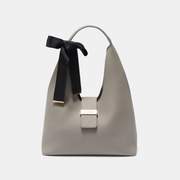“The real always reveals itself. I can tell if a bag is genuine leather just by the sound it makes.”
— Zendaya, 2025 Paris Fashion Week interview
In the world of fashion, every detail defines identity. Among these, bag models carry some of the boldest signatures. Wondering how to tell if a bag is genuine leather? It’s more than just appearance—it’s about the texture, scent, how it ages, and how it feels when lived with. Understanding what separates true luxury from imitation not only elevates your style but also marks the first step toward conscious consumption.
How to Tell If a Bag Is Genuine Leather: 7 Proven Ways
Before answering “how to tell if a bag is genuine leather,” let’s first explore the fundamental differences between synthetic and authentic leather. Here are the subtle signs that’ll help you avoid imitation traps:
1. The Touch Test: Truth in Texture
A true genuine leather bag feels warm, soft, and slightly textured. In contrast, synthetic leather is cold, smooth, and plasticky. Always start by running your fingers across the surface.
2. The Smell Test: Scent Never Lies
Real leather has a distinct earthy, organic scent. Fake leather often lacks any smell—or worse, carries a chemical or plastic odor.
3. Check the Stitching: Signs of Craftsmanship
In authentic leather bags, the stitching is even and neat. You might also notice smoothed and waxed edges—another indicator of quality and hand-finishing.
4. The Burn Test: For Leather Enthusiasts Only
While not recommended for the general public, collectors sometimes test a hidden corner. Real leather chars slightly and smells like burnt hair. Fake leather melts and gives off a burnt plastic scent.
5. Aging Gracefully: The Beauty of Patina
Real leather ages beautifully—stretching, darkening, and developing a unique patina over time. If a bag becomes richer and softer with use, it’s likely the real deal.
Label and Certification Check
Genuine leather bags are often labeled with terms like “genuine leather,” “top grain leather,” or “full grain leather.” However, labels can be faked—so know your brand. Reputable producers like Black Ribbon provide authenticity certificates and uphold ethical production standards.
Don’t Forget the Lining
High-quality leather bags often feature cotton, microfiber, or suede-style linings. Synthetic bags, in contrast, usually have polyester interiors, which feel colder and less refined.
Let the Price Guide You
Genuine leather is more expensive due to its natural material and craftsmanship. If a “leather” bag is unusually cheap, it likely uses synthetic substitutes or low-grade hides.
Trusted Brands Matter
Buying from a reliable label guarantees not just the material but also post-sale support and trend-forward design. Leading fashion houses—and collections like Dora and Victoria by Black Ribbon—set benchmarks for leather craftsmanship in 2025.
Genuine Leather in 2025 Fashion Trends
Wondering if genuine leather bags are still relevant in 2025? Absolutely. With a renewed focus on sustainability and timeless materials, authentic leather is thriving. Celebrities like Zendaya, Gigi Hadid, and Hailey Bieber continue to champion its elegance both on the runway and in streetwear.
Key Tips When Buying a Genuine Leather Bag
- Ask for a Warranty: It shows brand confidence and quality assurance.
- Read Online Reviews: Real user experiences can be telling.
- Expect Natural Wear: Patina is part of real leather’s charm.
- Watch Seasonal Trends: In 2025, earthy tones and structured silhouettes elevate leather’s role.
- Trust Your Senses: Texture, smell, weight—all reveal the truth.
How to tell if a bag is genuine leather? Discover 7 expert tips, key traits, and timeless women’s bag collections to spot true luxury.Final Thought: Quality Reveals Itself in Time
Asking how to tell if a bag is genuine leather is more than fashion curiosity—it’s a lifestyle choice. Authentic leather evolves with you, shaping itself to your daily rhythm and personal story. Whether you lean toward a sleek shoulder bag or a bold tote, let your choice reflect lasting value.
Frequently Asked Questions
What’s the main difference between genuine leather and synthetic leather bags?
The difference lies in the texture and smell. Real leather is soft and warm with a natural scent, while synthetic leather is smooth, colder, and may smell plastic-like.
How can I test if a bag is real leather at home?
Use your senses—touch, smell, and visual inspection of stitching. Check the label and evaluate if the price aligns with the material quality.
Does “genuine leather” label always mean high-quality?
Not necessarily. “Genuine leather” indicates real material but is the lowest quality grade. Look for “top grain” or “full grain” for superior options.
Can the inner lining help determine authenticity?
Yes. Cotton, microfiber, or suede-style linings suggest genuine craftsmanship. Polyester linings are common in synthetic bags.
Do genuine leather bags change color over time?
Yes. Real leather develops patina—a natural aging process that enhances depth, color, and uniqueness.
Are genuine leather bags still trendy in 2025?
Definitely. With sustainability and natural materials in focus, genuine leather bags are at the forefront of 2025 fashion both on and off the runway.



